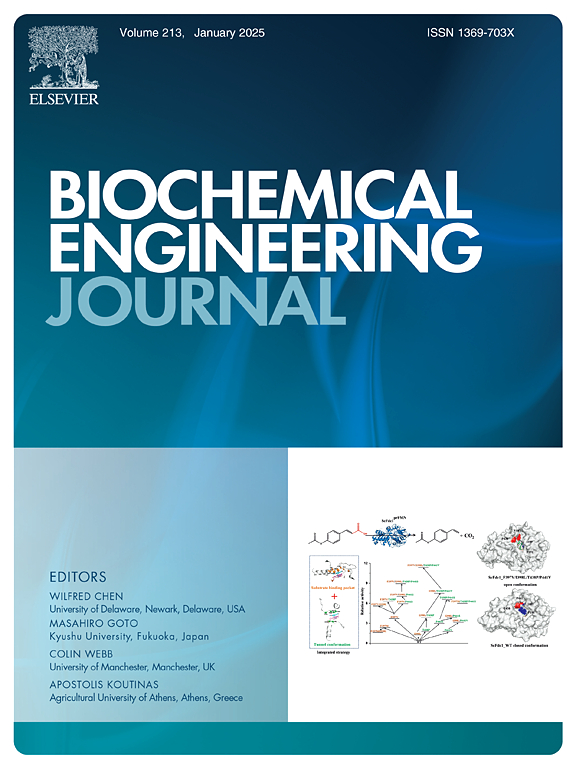Evaluating RNA ligases to facilitate the synthesis of circular mRNA
IF 3.7
3区 生物学
Q2 BIOTECHNOLOGY & APPLIED MICROBIOLOGY
引用次数: 0
Abstract
Circular mRNAs (circRNAs) have shown broad biological application prospects due to their unique closed structure and stability features. Among the methods for producing circRNAs, employing T4 ligases has been successfully developed as a straightforward approach. Expanding RNA research would benefit from the development of more RNA ligases. In this study, RNA ligases from different sources were selected and explored. By comparing the protein expression levels of seven newly constructed RNA ligases and the intracellular translation levels of their circRNA ligation products, the ligases from Naegleria gruberi, Methanothermobacter thermautotrophicus, and Rhodothermus marinus demonstrated better efficiency compared to T4 RNA ligase. Mouse studies further validated the functions of circRNA ligation products. This result can offer valuable guidance for synthesizing and applying circRNAs, enabling them to serve various functions in vaccines, protein replacement therapy, and gene editing.
评价RNA连接酶促进环状mRNA合成的作用
环状mrna (Circular mRNAs, circRNAs)由于其独特的封闭结构和稳定性特点,在生物学上具有广阔的应用前景。在产生环状rna的方法中,使用T4连接酶已被成功地开发为一种直接的方法。扩大RNA研究将受益于更多RNA连接酶的发展。在本研究中,选择并探索了来自不同来源的RNA连接酶。通过比较7种新构建的RNA连接酶的蛋白表达水平及其circRNA连接产物的胞内翻译水平,gruberi Naegleria、热自养甲烷菌(Methanothermobacter thermautotrophicus)和红热菌(Rhodothermus marinus)的连接酶比T4 RNA连接酶效率更高。小鼠研究进一步验证了circRNA连接产物的功能。这一结果可以为circrna的合成和应用提供有价值的指导,使其能够在疫苗、蛋白质替代治疗和基因编辑中发挥各种功能。
本文章由计算机程序翻译,如有差异,请以英文原文为准。
求助全文
约1分钟内获得全文
求助全文
来源期刊

Biochemical Engineering Journal
工程技术-工程:化工
CiteScore
7.10
自引率
5.10%
发文量
380
审稿时长
34 days
期刊介绍:
The Biochemical Engineering Journal aims to promote progress in the crucial chemical engineering aspects of the development of biological processes associated with everything from raw materials preparation to product recovery relevant to industries as diverse as medical/healthcare, industrial biotechnology, and environmental biotechnology.
The Journal welcomes full length original research papers, short communications, and review papers* in the following research fields:
Biocatalysis (enzyme or microbial) and biotransformations, including immobilized biocatalyst preparation and kinetics
Biosensors and Biodevices including biofabrication and novel fuel cell development
Bioseparations including scale-up and protein refolding/renaturation
Environmental Bioengineering including bioconversion, bioremediation, and microbial fuel cells
Bioreactor Systems including characterization, optimization and scale-up
Bioresources and Biorefinery Engineering including biomass conversion, biofuels, bioenergy, and optimization
Industrial Biotechnology including specialty chemicals, platform chemicals and neutraceuticals
Biomaterials and Tissue Engineering including bioartificial organs, cell encapsulation, and controlled release
Cell Culture Engineering (plant, animal or insect cells) including viral vectors, monoclonal antibodies, recombinant proteins, vaccines, and secondary metabolites
Cell Therapies and Stem Cells including pluripotent, mesenchymal and hematopoietic stem cells; immunotherapies; tissue-specific differentiation; and cryopreservation
Metabolic Engineering, Systems and Synthetic Biology including OMICS, bioinformatics, in silico biology, and metabolic flux analysis
Protein Engineering including enzyme engineering and directed evolution.
 求助内容:
求助内容: 应助结果提醒方式:
应助结果提醒方式:


